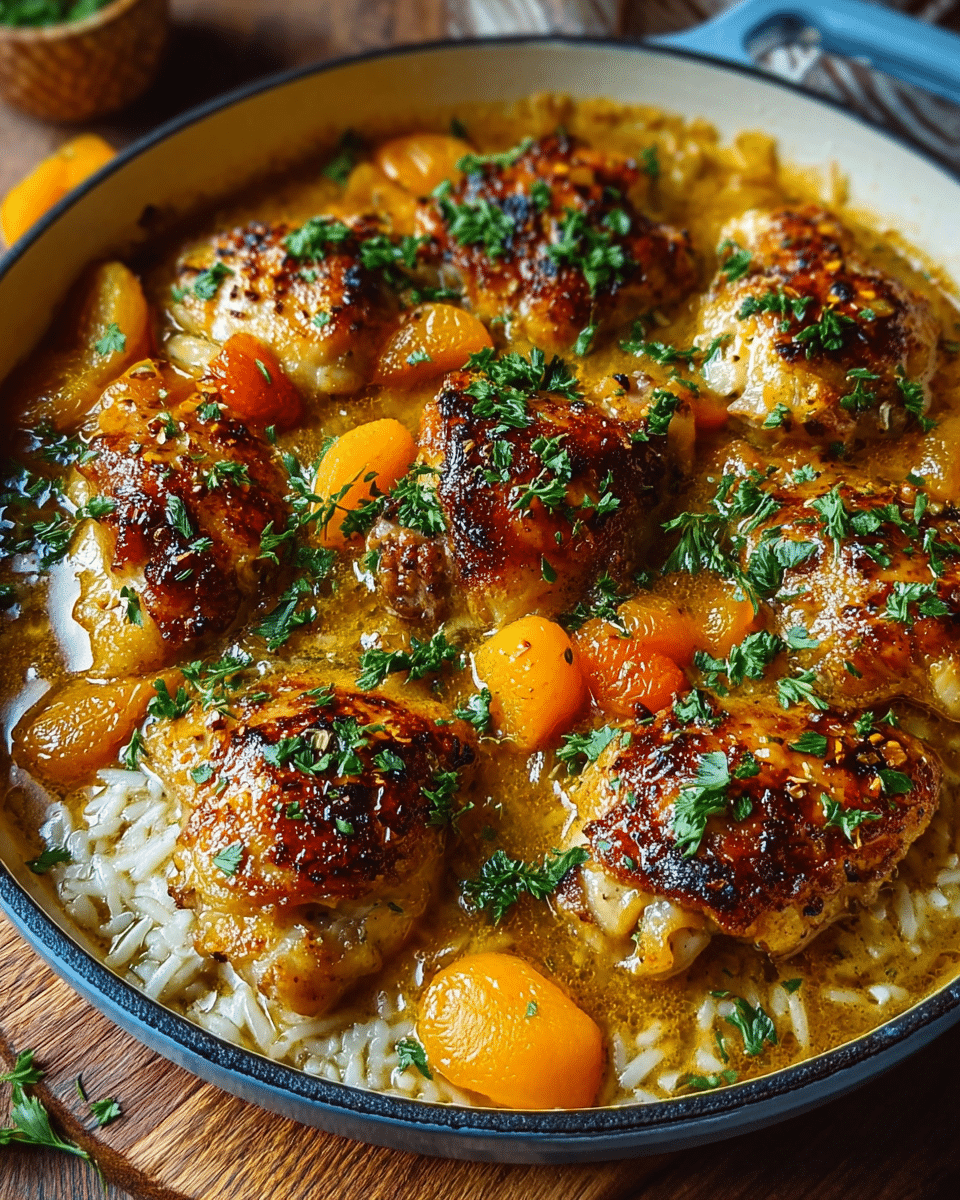The rich aroma of Persian Chicken fills the kitchen with the scent of cinnamon, cumin, and garlic an enticing prelude to a dish that perfectly balances sweet and savory. With golden chicken thighs simmered slowly in a broth infused with warm spices, softened apricots, and toasted nuts, every bite is a celebration of Iranian culinary heritage.
This dish is comforting and luxurious at once, yet simple enough to prepare on a weeknight. Serve it over fluffy saffron rice with a side of fresh cucumber-yogurt salad, and you’ll instantly elevate your dinner table. Whether you’re entertaining or simply indulging in something new, Persian Chicken is a delightful journey into taste and tradition.
Full Recipe:
Ingredients:
-
4 chicken thighs, bone-in and skinless
-
1 medium onion, finely chopped
-
3 cloves garlic, minced
-
2 tablespoons vegetable oil
-
1 teaspoon turmeric powder
-
1 teaspoon cinnamon powder
-
1 teaspoon cumin powder
-
1 teaspoon coriander powder
-
Salt and pepper to taste
-
2 cups chicken broth or water
-
1 cup dried apricots, halved
-
1 cup slivered almonds or walnuts
-
1 tablespoon fresh parsley, chopped (for garnish)
Directions:
-
In a bowl, season the chicken thighs with turmeric, cumin, coriander, cinnamon, salt, and pepper. Let them marinate for 15 minutes.
-
Heat oil in a large skillet or Dutch oven over medium heat. Sauté the chopped onions until golden, about 5-7 minutes.
-
Stir in the minced garlic and cook for another minute.
-
Add the marinated chicken and brown it on all sides, around 6-8 minutes.
-
Pour in the broth or water. Bring to a gentle boil.
-
Add the apricots and nuts, stirring gently.
-
Lower the heat to simmer, cover the pot, and cook for 45 minutes, or until the chicken is tender.
-
Taste and adjust seasoning as needed.
-
Garnish with chopped parsley and serve hot.
Prep Time: 15 minutes | Cooking Time: 60 minutes | Total Time: 1 hour 15 minutes
Kcal: 450 kcal | Servings: 4 servings
Exploring the Flavorful World of Persian Chicken: A Culinary Celebration of Iran’s Rich Heritage
Persian Chicken is more than just a recipe it is a dish that embodies the vibrant history and deeply rooted culinary traditions of Iran. Revered for its unique harmony of sweet and savory elements, this dish brings together tender chicken, warming spices, and the sweetness of dried fruits in a combination that is as comforting as it is exotic. Whether served at a family gathering or a festive dinner, Persian Chicken delivers not only nourishment but a sensory experience that captivates anyone who tastes it.
The Cultural Significance of Persian Chicken
Iranian cuisine is one of the oldest and most sophisticated in the world. It reflects thousands of years of cultural influence from regions like the Middle East, Central Asia, and the Indian subcontinent. Persian cooking is known for its balanced use of herbs and spices, use of seasonal ingredients, and attention to color and presentation.
Chicken dishes in Persian cuisine are highly regarded for their adaptability and deep flavors. From saffron-kissed chicken stews to grilled kabobs marinated in yogurt and lime, chicken has a revered place on the Iranian table. Persian Chicken with apricots and nuts is one such dish that captures the spirit of this culinary tradition. Often referred to as Khoresh-e Morgh ba Zardaloo (chicken stew with apricots), it symbolizes warmth, hospitality, and home.
A Flavor Profile That Dances Between Sweet and Savory
What makes Persian Chicken truly distinctive is its delicate balancing act between sweet and savory components. At its heart, the dish is seasoned with a blend of spices like turmeric, cinnamon, cumin, and coriander. These spices infuse the chicken with warmth and depth, creating a base that is earthy and slightly floral.
What surprises many first-timers is the addition of dried fruits most notably apricots. As they simmer alongside the chicken, these fruits plump up and release their natural sugars into the broth, lending a gentle sweetness that perfectly complements the spices. The final touch comes from toasted nuts often almonds or walnuts which add both richness and a welcome textural contrast.
This interplay of flavors aromatic, savory, fruity, and nutty mirrors the complexity of Persian culture itself, where art, poetry, and cuisine are intertwined.
Why You’ll Love It: Layers of Comfort and Complexity
Persian Chicken is a crowd-pleaser because it appeals to a wide range of palates. For those who are new to Middle Eastern flavors, it’s an accessible introduction flavorful but not overly spicy, exotic yet comforting. For those more experienced with the cuisine, it’s a nostalgic reminder of family meals and holiday feasts.
The dish is also incredibly adaptable. It can be served year-round, paired with different side dishes depending on the season. While it’s ideal for cozy winter meals thanks to its hearty nature, the freshness of parsley and citrus pairings also make it a refreshing option for spring and summer dinners.
Ideal Pairings and Serving Suggestions
One of the best ways to serve Persian Chicken is over a bed of fluffy saffron rice, which not only complements the flavors but also adds an eye-catching golden hue to the plate. Herbed rice, like Sabzi Polo, made with dill, parsley, and chives, also makes a wonderful accompaniment.
To add contrast and freshness, pair the dish with a cucumber-yogurt salad (Mast-o-Khiar), a traditional Persian side that cools the palate and adds a tangy element to the meal. For added crunch, a simple Shirazi salad made with finely chopped cucumber, tomato, onion, and lemon juice is another excellent choice.
Warm flatbreads like lavash or taftoon can be served on the side for scooping up the sauce, while pomegranate seeds or a squeeze of lime juice make for attractive garnishes that add both color and zing.
Variations Worth Exploring
One of the strengths of Persian Chicken is its adaptability. While the classic version includes apricots and almonds, there’s plenty of room for experimentation:
-
Alternative Fruits: Try substituting apricots with dried prunes, golden raisins, or even dried cherries for a more tart edge.
-
Different Nuts: Pistachios can replace almonds or walnuts for a more traditional Iranian twist.
-
Vegetarian Option: Swap out the chicken for hearty vegetables like eggplant or cauliflower. Chickpeas and lentils also work beautifully in this dish.
-
Fresh Herbs: Add a handful of chopped cilantro or mint toward the end of cooking for an herbal lift.
-
Extra Heat: If you prefer spicier dishes, a touch of cayenne or chili flakes can be added without overwhelming the existing flavors.
A Healthy, Wholesome Choice
In addition to being incredibly flavorful, Persian Chicken is a nourishing dish that aligns well with many dietary preferences. Chicken thighs are a great source of protein and, when cooked slowly, become tender and juicy without the need for added fats. The inclusion of dried fruits adds fiber and antioxidants, while nuts bring in healthy fats and essential minerals.
The dish is also naturally gluten-free, making it suitable for those with gluten sensitivities (as long as the broth and seasonings are verified to be gluten-free). If you’re watching your sugar intake, the sweetness from the apricots is subtle and balanced by savory spices, so it doesn’t spike blood sugar the way added sugars might.
For meal preppers, this dish is an excellent choice. Persian Chicken actually tastes even better the next day as the flavors continue to meld, and it stores well in the refrigerator for up to four days. It also freezes beautifully.
Tips for Home Cooks
Even if you’re new to Persian cooking, this dish is relatively simple to master. The key is patience allowing the chicken to slowly simmer so that it absorbs all the flavors from the broth and spices. Here are a few quick tips to help:
-
Use a heavy-bottomed pot or Dutch oven to ensure even cooking and prevent burning.
-
Let the spices bloom. Take a moment to sauté your spices in the oil before adding liquids; this enhances their aroma and depth.
-
Taste as you go. Every dried fruit has a different level of sweetness, so you may want to adjust the seasoning toward the end of cooking.
-
Don’t rush the simmer. A gentle, covered simmer allows the flavors to develop fully.
Conclusion:
Persian Chicken is not just a meal it’s a sensory journey through one of the world’s oldest and richest culinary traditions. With its aromatic spices, sweet accents, and comforting textures, this dish is perfect for special gatherings, weeknight dinners, or even as a unique offering for a holiday meal.
Its versatility, health benefits, and cultural richness make it an exceptional addition to any home cook’s repertoire. Whether you’re preparing it for the first time or returning to it as a beloved staple, Persian Chicken invites you to slow down, savor, and share. And in doing so, it captures exactly what great cooking is all about: warmth, connection, and the joy of a meal well made.






